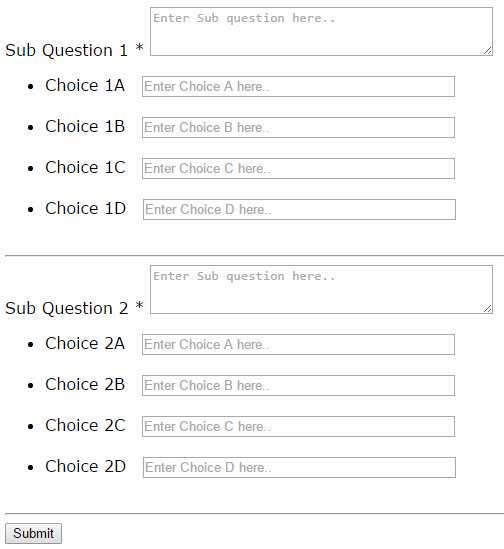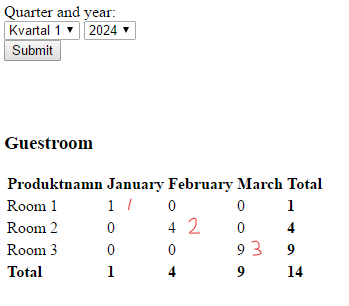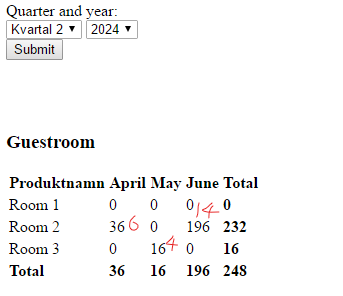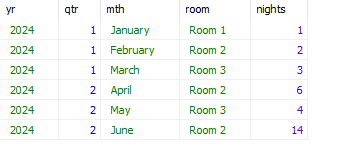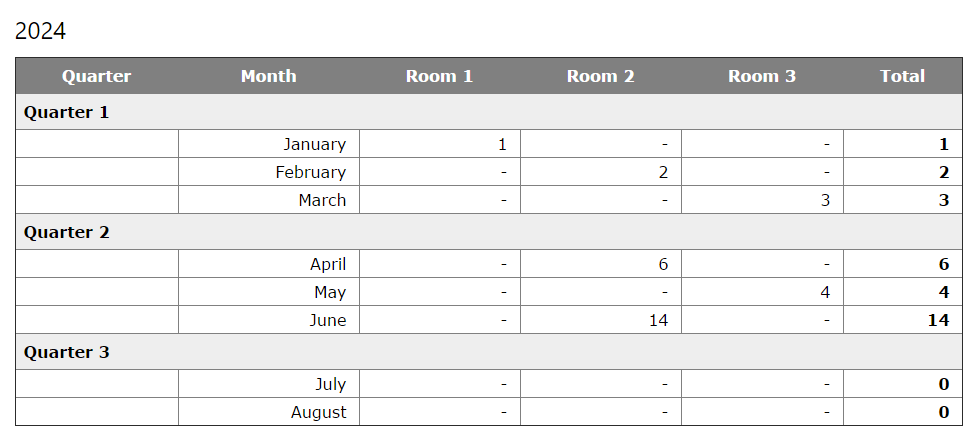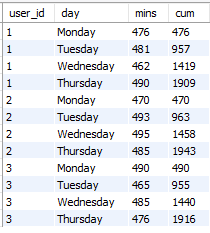Leaderboard
Popular Content
Showing content with the highest reputation since 07/26/2024 in all areas
-
Highly recommend switching to a library like PHPMailer or SwiftMailer - they're both easier to use and more reliable than php's native mail function.2 points
-
the most common reason for a password_hash()/password_verify() to fail is because the database column is not long enough to hold the hashed value. another common reason are programming mistakes in the form/form processing code and a lack of server-side validation that results in the hash value not actually being from the password that was submitted in the registration code, or the value being used in the login code not being what you think it is. your post method form processing code should always trim the input data, mainly so that you can detect if all white-space characters were entered, then validate all inputs before using them.2 points
-
the file system path/filename must be to where the file is located on the disk, either using a relative path (relative to the file with the include/require starting in it) or an absolute path. a leading / refers to the root of the current disk, which is doubtful where that file is located, and which will be producing a php error about a non-existent path/file. you must get php to help you by reporting and displaying all the errors it detects. you can temporarily set php's error_reporting/display_errors in your code (you will want to remove the settings when you are done learning, developing, and debugging). you can add the following immediately after the first opening <?php tag in the main file - ini_set('display_errors', '1'); error_reporting(-1);2 points
-
I'd do something like this... <?php $data = [ '46.105.73.18:27015' => [ 'gq_address' => '46.105.73.18', 'gq_dedicated' => '', 'gq_gametype' => '', 'gq_hostname' => '', 'gq_joinlink' => 'steam://connect/46.105.73.18:27015/' , 'gq_mapname' => '', 'gq_maxplayers' => '', 'gq_mod' => '', 'gq_name' => 'Counter-Strike: Source' , 'gq_numplayers' => '', 'gq_online' => '', 'gq_password' => '', 'gq_port_client' => 27015 , 'gq_port_query' => 27015 , 'gq_protocol' => 'source' , 'gq_transport' => 'udp' , 'gq_type' => 'css' , 'players' => Array (), 'teams' => Array () ] ] ; $tdata = ''; foreach ($data as $k => $v) { $v = array_filter($v); // get rid of blank values $tdata .= "<table border='1'> <tr><th>Array key</th><th>" . join('</th><th>', array_keys($v)) . "</th></tr>\n"; // output headings $tdata .= "<tr><th class='rowth'>$k</th><td>" . join('</td><td>', array_values($v)) . "</td></tr> // output values </table>\n"; } ?> <html lang='en'> <head> <meta 'charset'='utf-8'> <title>Example</title> <style type='text/css'> table { border-collapse: collapse; margin-bottom: 10px; } th { background-color: #444; color: white; padding: 8px; } .rowth { background-color: #888; } td { padding: 8px; text-align: center; } </style> </head> <body> <?= $tdata ?> </body> </html> Giving ...2 points
-
First step to manually parsing HTML is to stop manually parsing HTML. Use DOM instead.2 points
-
After about 3 hours of waiting I killed the process as the SQL server never showed a status other than "idle". I think it hit a problem and got itself into an infinite loop doing nothing. To give myself some data to work with, I managed to extact the table structure , the first 3,400 and the last 600 records from the sql file. I could have done all of them but it (thankfully) uses multiple row inserts (1700 at a time) and it takes an age scrolling through the text to find each block's start and end then select the block. There are about 200 such blocks and each takes about 2.5 seconds to load the data - so the whole load should have taken 8-9 minutes. Enough of the excuses. I finally came up with a solution using the post table. The first part (WITH ...) creates a temporary table called "plast" which contains a row for each threadID with the latest date of all the posts for the thread. The main part of the query (SELECT ...) matches the threadid/latest date with the post table to find the matching post and also joins to the thread table to pick uo thread info. Finally, I limit the output to just those dates in the last 7 days. (Apologies for screwing up the text encoding along the way - eg "Jürgen Peters". It's only test data.) WITH plast AS ( SELECT threadID , MAX(time) as latest FROM wbb1_1_post GROUP BY threadID ) SELECT t.threadID , t.topic , p.userID , p.username , p.postid , FROM_UNIXTIME(p.time) AS time , FROM_UNIXTIME(plast.latest) AS latest FROM wbb1_1_post p JOIN wbb1_1_thread t ON p.threadID = t.threadID JOIN plast ON plast.threadid = p.threadid AND plast.latest = p.time WHERE FROM_UNIXTIME(p.time) > CURDATE() - INTERVAL 7 DAY ; +----------+----------------------------------------------------------------+--------+------------------+--------+---------------------+---------------------+ | threadID | topic | userID | username | postid | time | latest | +----------+----------------------------------------------------------------+--------+------------------+--------+---------------------+---------------------+ | 131549 | welche Spinne? --> eventuell Lepthyphantes sp. | 5455 | Manfred Zapf | 507256 | 2025-01-26 10:08:19 | 2025-01-26 10:08:19 | | 131698 | Baumwanze | 1397 | zobel | 507259 | 2025-01-26 12:48:43 | 2025-01-26 12:48:43 | | 56659 | Grüne Futterwanze? | 15196 | Christine | 507261 | 2025-01-26 14:57:09 | 2025-01-26 14:57:09 | | 131576 | Kleine schwarze Spinne --> Enoplognatha cf. thoracica | 15395 | Bernd 07 | 507263 | 2025-01-26 16:01:45 | 2025-01-26 16:01:45 | | 131307 | Amaurobius fenestralis? --> bestätigt | 15395 | Bernd 07 | 507264 | 2025-01-26 16:08:09 | 2025-01-26 16:08:09 | | 131701 | Unbekannte Schneckenart | 15395 | Bernd 07 | 507267 | 2025-01-26 16:43:50 | 2025-01-26 16:43:50 | | 131702 | Encyrtidae? | 11406 | JohnEs81 | 507268 | 2025-01-26 17:00:37 | 2025-01-26 17:00:37 | | 131700 | Welche Wanze ist das? --> Arocatus longiceps | 15395 | Bernd 07 | 507272 | 2025-01-26 17:36:02 | 2025-01-26 17:36:02 | | 131699 | Tegenaria --> nein sondern Amaurobius similis/fenestralis | 1999 | Klaus Fritz | 507274 | 2025-01-26 17:48:07 | 2025-01-26 17:48:07 | | 131683 | Grüne Larve -> Geometridae Art | 11406 | JohnEs81 | 507280 | 2025-01-26 20:41:49 | 2025-01-26 20:41:49 | | 131703 | eine Acericerus heydenii? | 1 | Jürgen Peters | 507282 | 2025-01-26 20:45:32 | 2025-01-26 20:45:32 | | 131687 | Zygina nivea? | 15392 | Sascha_N | 507286 | 2025-01-26 21:15:21 | 2025-01-26 21:15:21 | | 131686 | Welcher Schnellkäfer? --> Melanotus sp. | 15395 | Bernd 07 | 507287 | 2025-01-26 21:29:11 | 2025-01-26 21:29:11 | | 131693 | Lispocephala brachialis --> bestätigt | 15800 | Bernd Cogel | 507293 | 2025-01-26 22:06:16 | 2025-01-26 22:06:16 | | 131704 | Cantharis paradoxa? --> Cantharis sp., ein schwarzer, immerhin | 15335 | Simeon Indzhov | 507295 | 2025-01-26 22:29:15 | 2025-01-26 22:29:15 | | 131695 | Peyerimhoffina gracilis? | 15335 | Simeon Indzhov | 507296 | 2025-01-26 22:36:08 | 2025-01-26 22:36:08 | | 131705 | Phytoecia coerulescens? | 1 | Jürgen Peters | 507297 | 2025-01-26 22:52:48 | 2025-01-26 22:52:48 | +----------+----------------------------------------------------------------+--------+------------------+--------+---------------------+---------------------+ Are you planning on rebuilding the database?2 points
-
you are doing 'date-ination'. it's like pagination, but using dates. you should be using a get request to determine what will be displayed on the page. this is so that if someone finds a result they would like to return to or share, they can bookmark or share the URL and can return to the same result. the dates you pass in the URL should be a standard YYYY-MM-DD format. format the dates as 'l j M' only when you display them. you would default to the current monday if there is no get input. you would produce the previous/next links with the previous/next monday's date and include any existing get parameters so that if you add other search/filters, they will automatically get propagated in the URL between pages. example code - <?php date_default_timezone_set('America/Denver'); // default to the current monday if there is no get input if(!isset($_GET['fdw'])) { $dw = new DateTime('monday this week'); $fdw = $dw->format('Y-m-d'); } else { // you should validate that the get input is a properly formatted date - code left up to you $fdw = $_GET['fdw']; } // use $fdw in your code to produce the output $dw = new DateTime($fdw); echo $dw->format('l j M') . '<br>'; // get a copy of any existing get parameters $get = $_GET; // produce the previous link // calculate previous date $dw = new DateTime($fdw); $pw = $dw->modify('-1 week'); $pfdw = $pw->format('Y-m-d'); // set the fdw element $get['fdw'] = $pfdw; // build the query string part of the url $qs = http_build_query($get,'','&'); echo "<a href='?$qs'><button>< Previous Week</button></a>"; // produce the next link // calculate next date $dw = new DateTime($fdw); $nw = $dw->modify('+1 week'); $nfdw = $nw->format('Y-m-d'); // set the fdw element $get['fdw'] = $nfdw; // build the query string part of the url $qs = http_build_query($get,'','&'); echo "<a href='?$qs'><button>Next Week ></button></a>";2 points
-
It might work a little more cleanly in PHPStorm, but when I tried it in VS Code, I found it much more complicated to try to select text or read through code when the editor was injecting those things into the view. Maybe if they weren't inline, though I can't imagine how not, they might be nicer for me... But I'm also a proponent of the idea that you should be able to tell what the parameter is, be that through a variable name or an obvious literal value (or a constant...), and if you can't tell then you should do something about that. // this is obvious on what the parameters are password_verify($password, $hashedPassword) // this is not password_verify($value, $row[1])2 points
-
Judicious application of array key names can greatly increase the efficiency and simplicity of your code. Consider this simplified version of the questions/options form code <form method='post' > <?php for ($qno=1; $qno<=2; $qno++) { echo <<<HTML <label> Sub Question $qno <span class="req">*</span> <textarea cols="46" rows="3" name="Q[$qno][question]" placeholder="Enter Sub question here.."></textarea> </label> <ul> HTML; for ($opt='A'; $opt<='D'; $opt++) { echo <<<HTML <li>Choice $qno$opt (text) <input type='text' name="Q[$qno][opts][$opt]" placeholder="Enter Choice A here.." size='40'> </li><br><br>\n HTML; } echo "</ul><hr>\n"; } ?> <input type='submit'> </form> producing... When the form is submitted, the POST array is like this... Array ( [Q] => Array ( [1] => Array ( [question] => aaaaaaaaaaaaaaaaaaaaaaaaaaa [opts] => Array ( [A] => aa [B] => bb [C] => cc [D] => dd ) ) [2] => Array ( [question] => bbbbbbbbbbbbbbbbbbbbbbbbb [opts] => Array ( [A] => ww [B] => xx [C] => yy [D] => zz ) ) ) ) Now you can easily iterate through the array to write the questions/options to you database foreach ( $_POST['Q'] as $qno => $qdata ) { write $qno and $qdata['question'] to question table save last insert id as $qid foreach ( $qdata['opts'] as $ono => $choice ) { write $qid, $ono, $choice to choice table } } Job Done.2 points
-
Unchecked checkboxes are not posted. I prefer to use a the null coalescing operator (??) when handling checkboxes EG $Bold = $_POST['Bold'] ?? 0; //if not set, default to '0'2 points
-
I had to create my own test data (thanks for that) but naturally I don't know how it conforms with yours. TABLE: product TABLE: bookingItem +----+-------------+-----------+--------+ +----+-----------+---------------------+---------------------+----------+ | id | productName | category | status | | id | productid | startTime | endTime | quantity | +----+-------------+-----------+--------+ +----+-----------+---------------------+---------------------+----------+ | 1 | Room 1 | Guestroom | Active | | 1 | 1 | 2024-01-01 11:32:01 | 2024-01-02 11:32:59 | 1 | | 2 | Room 2 | Guestroom | Active | | 2 | 2 | 2024-02-01 11:34:08 | 2024-02-03 11:34:24 | 2 | | 3 | Room 3 | Guestroom | Active | | 3 | 3 | 2024-03-01 11:34:56 | 2024-03-04 11:35:08 | 3 | | 4 | Room 4 | Guestroom | NULL | | 4 | 2 | 2024-04-01 12:20:20 | 2024-04-07 12:20:41 | 6 | | 5 | Room 5 | Guestroom | NULL | | 5 | 3 | 2024-05-01 01:21:49 | 2024-05-05 12:21:58 | 4 | +----+-------------+-----------+--------+ | 6 | 5 | 2024-06-19 12:23:03 | 2024-06-29 12:23:28 | 10 | | 7 | 2 | 2024-06-01 13:02:51 | 2024-06-15 13:03:16 | 14 | +----+-----------+---------------------+---------------------+----------+ On running your code with my data I get these results for Q1 and Q2. I have written the correct totals in red. As you can see there is a distinct pattern - your totals are the correct totals squared. However, I could not spot any multiplication in the code (I ran as separate query to confirm the correct totals) I have to say, in your code you really make a meal of those dates in the years and quarters considering that SQL can handle it easily. Here's my version... <?php ############################################### # CREATE YOUR OWN PDO DATABASE CONNECTION # # # require 'db_inc.php'; $pdo = mdbConnect('db1'); # # # # ############################################### $range = [ '2020-01-01', '2024-07-31' ]; $selectedYear = $_GET['year'] ?? 0; $whereYear = ''; if ($selectedYear) { $whereYear = 'AND YEAR(d.dt) = ?'; $range[] = $selectedYear; } $res = $pdo->prepare("WITH RECURSIVE dates(dt) AS ( SELECT ? UNION ALL SELECT dt + INTERVAL 1 MONTH FROM dates WHERE dt < ? ) SELECT YEAR(d.dt) AS yr , QUARTER(d.dt) as qtr , MONTHNAME(dt) AS mth , productName AS room , COALESCE(SUM(DATEDIFF(endTime, startTime)), '-') AS nights FROM product p CROSS JOIN dates d LEFT JOIN bookingitem b ON b.productid = p.id AND YEAR(d.dt) = YEAR(b.startTime) AND MONTH(d.dt) = MONTH(b.startTime) WHERE p.`status` = 'Active' $whereYear GROUP BY yr, qtr, MONTH(d.dt), p.id "); $res->execute($range); $results = $res->fetchAll(); $rooms = array_unique(array_column($results, 'room')); $theads = "<tr><th>Quarter</th><th>Month</th><th>" . join('</th><th>', $rooms) . "</th><th>Total</th></tr>\n"; ### RESTRUCTURE THE RESULTS ARRAY foreach ($results as $r) { $data[$r['yr']][$r['qtr']][$r['mth']][$r['room']] = $r['nights']; } ?> <!DOCTYPE html> <html lang='en'> <head> <meta charset="utf-8"> <title>Example</title> <link rel="stylesheet" href="https://www.w3schools.com/w3css/4/w3.css"> <style type='text/css'> table { width: 100%; border-collapse: collapse; } th { background-color: #808080; color: white; padding: 8px; } td { padding: 4px 12px; text-align: right; } .ca { text-align: center; background-color: #EEE; } .la { text-align: left; background-color: #EEE; color: black; } </style> </head> <body> <header class='w3-indigo w3-padding w3-margin-bottom'> <h1>Guestroom Occupancy</h1> </header> <div class='w3-content w3-padding'> <?php ## OUTPUTFROM RESTRUCTURED ARRAY foreach ($data as $yr => $ydata) { echo "<h3>$yr</h3>\n <table border='1'> $theads "; foreach ($ydata as $qtr => $qdata) { $span = 3 + count($rooms); echo "<tr><th class='la' colspan='$span'>Quarter {$qtr}</th></tr>\n"; foreach ($qdata as $mth => $mdata) { echo "<tr><td> </td><td>$mth</td><td>" . join('</td><td>', $mdata) . "</td><td><b>" . array_sum($mdata) . "</b></td></tr>\n"; } } echo "</table>\n"; } ?> </div> </body> </html> Output2 points
-
the above line is missing any { }, so the only line of code that gets executed for an is_dir() is the - echo '<strong>'.$directory .'</strong> <br>'; all the rest of the lines get executed regardless of what $directory is. i recommend that you always format your code so that you can see when it is actually doing.1 point
-
Done this for many systems: 100% agree with Barand. I will go one step further and make this an "event" table where the system can insert rows for other events. Off the top of my head other events (in an event_type table or enum) would be a list like this: login logout bad password attempt change password reset password request etc. A simple table like this is common, has and has the benefit (with proper indexing) of allowing for the types of analysis and controls Barand listed. It also allows for mitigating brute force password attempts, as you can use this table to limit the number of login attempts within a given time period for a specific user, and lock the account after a certain number of attempts. Beyond the relationship to the User table (by Id) and a timestamp, you also typically want to store the IP address of the client. If it's mysql, the best way to do this (and natively support both IPv4 and IPv6) is to store the IP as VARBINARY(16) and use the INET6_ATON() and INET6_NTOA() functions to convert the IP when storing and retrieving. Small tables like this, with a clear design scale very well, as MySQL/MariaDB (using the InnoDB engine) is tuned to maximize Select & Insert concurrency. Often people will attempt to use a column or 2 in the user table, which they repeatedly update (ie. "last_login") which reduces concurrency, and is also less valuable than having a full history.1 point
-
E_DEPRECATED and E_USER_DEPRECATED are the same thing, with the one difference that the former is used by the engine and the latter is used by trigger_error. So the question is in what environments do you care/not care about getting messages about using deprecated features and functionality?1 point
-
1 point
-
Services Offered has been a place for people to offer their services for hire. Over time, it's "evolved" to support companies to announce themselves as well (provided their services are on-topic), and today it primarily functions as a pseudo-sanctioned forum for spam. There's a slight moderation burden in monitoring it for off-topic spam and removing replies (which are against rules but the forum software isn't able to enforce this adequately). Job Offerings has been the other side of the coin, where people and companies could post about jobs they have available. It doesn't see much activity these days - 5 threads in the last two years. Given that Services Offered is more of a burden than a benefit and that Job Offerings isn't much of an offering anymore, we're looking to close them down within the next week or so. Thoughts?1 point
-
You're assigning $addingTenMinutes but then using $addingFiveMinutes, which doesn't exist. Also, strtotime('now() + 10 minute') is not a valid syntax for strtotime. Here is a corrected version: $addingTenMinutes = strtotime('+10 minutes'); $end_time = date('Y-m-d H:i:s', $addingTenMinutes);1 point
-
so, i found the problem, with the help of php's error reporting, though the problem is in javascript. you are echoing blocks of static html/javescript using php's heredoc syntax. when I made the test page i used, the javascript was simply in-line. you are using template literals with embedded expressions in the javascript, e.g. ${some_var}. however, in php's heredoc syntax, this is the syntax for a php variable. so, php is putting the last value for any of its variables with the some_var name into the echoed javascript. how i found this is that the embedded expressions in the openUpdateTotalsPopup() javascrpt, for ${width}, ... produced undefined php variable errors. the simplest fix would be to use php's nowdoc syntax. the correct solution would be to NOT echo blocks of static html/javascript, which I see i wrote about in one of your previous threads.1 point
-
you should do this directly in the sql query statement. MySql has a large number of datetime functions. what is the format of the 'date' column in the database table? if you do this in the php code, you must either compare objects with objects or compare formatted strings with formatted strings, with the same exact format, in a left-right order from most significant field (year) to least significant field (day.) the current php code produces a fatal error at the date_diff() method call, because the 2nd argument must be an object, not the $data["date"] string. $date is a datetime object, you cannot directly compare it with the $data["date"] string. you either must use the datetime ->format() method to produce a formatted string from the $date object, or you must create a datetime object from the $data["date"] string. $diff in a dateinterval object. to get the number of days, you would need to use the dateinterval ->format() method with the '%a' format specifier to produce the whole number of days.1 point
-
you still have not provided any context (meaning) of this data. name-numbered, labels and variables, are meaningless to us. if the mix of rows shown in the example picture is valid, i.e. you can have have any number of rows from each html table section, you should (probably) store the data from each row in each html table as a separate row in the detail database table, with an item_id column to indicate the meaning of each row of data. i have a recommendation for the dynamically added markup. don't write out the markup in the javascript yourself, where you have to keep it updated to match any changes or corrections (you are going to need to eliminate the use of duplicate ids) you make to the markup being output on the page. instead, define/store the output being output on the page in a php variable, so that you can echo it on the page and echo it as the markup inside the javascript. if you use back-ticks (template literals) around what you echo in the javascript, you can use the exact same markup in both cases. see this link - https://developer.mozilla.org/en-US/docs/Web/JavaScript/Reference/Template_literals1 point
-
mac_gyver is 100% correct with those suggestions. I will add that using '?' placeholders can get confusing if you've got several to many variables in your query - in this case i recommend named placeholders. So, to update mac_gyver's perfectly good code as an example, $sql = "Select * FROM weekends WHERE Weekend_Number = :weekendNumber AND Men_Women = :menWomen"; $stmt = $pdo->prepare($sql); $stmt->execute([ 'weekendNumber' => $_SESSION['Weekend_Number'], 'menWomen' => $_SESSION['Men_Women'] ]); Note that another benefit of using PDO over mysqli is that you don't have to bind the parameters separately. It's been a while since I used mysqli, but i think i remember having to bind the result values as well? If I'm remembering correctly, this is another thing you don't have to do with PDO.1 point
-
i second the use of prepared statements. you MUST protect against sql special characters in a value being able to break the sql query syntax, which is how sql injection is accomplished. a prepared query is the simplest (provided you use the much simpler and better designed PDO extension), fool proof way of accomplishing this for all data types. also, if the 'th' (ordinal indicator) is actually part of the value, it should not be. this is a human convention and should only be displayed, not actually submitted or stored. you should only submit or store the integer value. the code copying session variables to other variables is both unnecessary (just use the original variable that data is in) and indicates that your form and form processing code is on different pages. by separating these, you are nearly doubling the amount of code and since it takes more code to accomplish a task, you are likely leaving out things that provide security or a good User eXperience (UX.) the code for any page should be laid out in this general order - initialization post method form processing get method business logic - get/produce data needed to display the page html document1 point
-
You INSERT new records. You UPDATE existing records. When you do this, you replace the values that were in that record before you updated it. There is no way around this - it's just how databases work. What you're attempting to do is an UPDATE: UPDATE `table` SET field5 = 'value1' WHERE field1 = 'value2' AND field2 = 'value3' Regards, Phill W.1 point
-
/homepages/29/d1007800584/htdocs is your site root - this is set by your host at the server level. If site-header.php and tester-include.php are both in the /page/ directory, the include from tester-include.php should be simply `require_once('./site-header.php');` If that still doesn't work, try `require_once(dirname(__FILE__).'/site-header.php');` (if site-header.php is in a sub-directory called /root/, add that into the require). As an aside, your host should be on php 8.1 at the least - 7.4 reached end of life in November 2022. You may want to ask them why they haven't upgraded yet. If they can't give you a decent answer, there are plenty of low-cost modern hosts around - ask here. Someone can point you in the right direction.1 point
-
First an editorial comment: Please do not take screen shots of code for your questions. We can't use that in our replies or help. We have a code block for a reason. You can easily copy/paste snippets of relative code into the code block, and that makes it possible for us to make edits based on the original code. Nobody here likes having to re-type parts of your code. Paths in your html are relative to the document root. The document root is a function of the web server configuration for the server or vhost you have configured. The types of things you can refer to in an html script are only things that the server understands to have an associated URL. In other words, they are things that you could use a url to access directly from your website. PHP works entirely with files, and file system paths on your workstation. Using PHP code to open include/require files always requires a file system path. When you include a file, the "working directory" for PHP is the path/location in the server file system where the script exists. So to include a php script from another php script you have 2 options: Provide the fully qualified path to the script. Because this path is operating system dependent, you typically don't want to do this as it requires you to add configuration in a file or even edit your source code purely because you moved servers. A Relative Path This is relative, again to the directory where the script that is including this code is. Relative paths can utilize 2 "special files": "." is the current directory. ".." is the parent directory. We don't know what the file system layout is for your project, so we can only guess at the correct path relative to the index.php? or whatever file it is that you are trying to do this php include in is named. If this directory has a sub-directory named "page" and you have put the site-header.php script into that directory, then the relative path you want to use will be: include("page/site-header.php"); This is how you specify a subdirectory path relatively. If you include a leading "/" that is considered the "root" directory of the filesystem. One other thing you might want to do is change include to require_once(). With a require_once() the script will actually error out rather than continue to run along without regard to the fact that your include failed.1 point
-
only checked checkboxes are set in the submitted form data. for what you are doing, you should only be concerned if they are set or are not set, not what the value is (the default value will be the text 'on'). i recommend that make an array that defines the checkbox field names and labels, then loop over this defining array to dynamically produce the form fields, pre-checking any existing checked boxes, in the case of a user/validation error, then loop over this defining array in the post method form processing code, testing which one(s) are set or are not set in the form data to produce whatever result you want.1 point
-
Basically what is being described to you is a race condition. You aren't going to be able to hack around it. A PHP script runs on the server, and has "page/request" scope. The client provide an HTTP request, and the server provides an HTTP response, and the connection is closed. Ajax is used to make changes to the state of a fully rendered DOM on the client. You are not going to be able to trick PHP into doing some of its work -- delaying while the client's DOM is in a partial/indeterminate state, in order for ajax to spawn another request, and then have the original PHP script resume in the way you hope it will, all so that you can get access to session variables that didn't even exist when the original HTTP request was made. I have no idea why you are trying to store some client state in a session, given that browser dimensions are dynamic, relative to the device and decisions made by the client. It's not clear what you expect to do with these dimensions, which you're getting from javascript code, but you certainly don't need to put them into a session, and you haven't made an attempt to explain what problem you are trying to solve, but this is not the way to solve whatever problem that is. If you want to actually take the time to explain the "problem to be solved" we might be able to better advise you on ways to solve it.1 point
-
Could be there is no data in the table for the last 7 days. Try "- INTERVAL 1 MONTH"1 point
-
Thank you. You should know that i have a text file of data that you have posted. I always appreciate the wisdom from the top talent here at phpfreaks. I have learned alot from this forum and its top members. I give credit where credit is due. I actually learned how this JOIN is working and i have successfully implemented my own query on the db last night before bed. I'll post the code in a reply to Barry. My point is that i learn from Barry and not simply take code and be on my way. I'm not looking for a free ride, only help when something is above my current level of knowledge. I hope that you have a splendid day, Gizmola.1 point
-
Yes this is common practice. When you first introduce a table you can alias it. You are then free to alias all the columns which can be quite a time saver when you have joined tables together, using "alias.column_name" as Barand did. You can do this explicitly using the 'AS' keyword but you can also omit the 'AS'. It's up to you, but I typically will abbreviate the name in some way, as do most experienced developers, such that your alias is at most a few letters. You should also notice, that he used an alias for the computed columns. Column names can also be aliased, and it's also a common practice. FROM_UNIXTIME(t.time) AS time So in this case you have an example of both alias options being used: thread table was aliased to t Used the t alias to specify the time thread.time field being passed to the FROM_UNIXTIME() SQL function the result of the function being aliased to the name 'time' in the final result set Also time was used in the order by. MySQL allows you to do this (use an aliased column name in an ORDER BY) although not all RDBMS do.1 point
-
Barry is truly a master of relational database design, implementation and SQL. However , at least initially, a small investment on your part in learning how to join tables together, will dramatically improve your understanding of his analysis and the SELECT statement he provided you. I browsed this material and it's a solid free tutorial on Joins using MySQL. https://www.mysqltutorial.org/mysql-basics/mysql-join/ You may see references to ANSI standard SQL, which is a standard for portable SQL syntax that should be compatible with most relational databases, but I did want to mention that different databases will have features that are specific to their implementation (non-standard), so you might see that in the case of joins there is more than one syntax possible, but they all do the same things. Don't let that confuse you -- JOINS are an essential concept that all relational databases implement. If you have an option, and can use ANSI standard syntax, opt for that, but it really doesn't matter that much, so long as you are clear on what the join produces. A basic understanding of Set theory might give you some insight into the ideas that went into relational database management (union, intersection, difference, subset) might help as well. This article cover the topic pretty well, and you may notice some of the overlap in concept and terminology: https://kyleshevlin.com/set-theory/ It's also worth learning how to read an Entity-Relationship-Diagram (ERD). Once you understand the fundamentals, you should be able to look at an ERD and understand how tables can be joined together. There are also many tools that people use to design or reverse engineer databases. For example, mysql provides ERD design features in their free SQL Workbench tool. ERD's are the way that people socialize a database design, and are the documentation that teams use to document for developers, the database design.1 point
-
Hi everyone! My name is Jerry, and I’m new to the PHP Freaks community. I’m just starting to learn more about PHP and web development, and I’m excited to be part of this group. I’m here to improve my coding skills, learn best practices, and hopefully contribute to discussions as I grow. If you have any advice for a beginner or resources you recommend, I’d love to hear about them! Looking forward to connecting with you all and learning more about PHP. Best regards, Jerry1 point
-
You can add a usort function, which sorts the $files1 array based on the modification time of each file. Something like this: usort($files1, function($a, $b) { return filemtime($b) - filemtime($a); }); I would also recommend using htmlspecialchars for added security. Hope this helps.1 point
-
Can you put your code in a code block in the future? Reading/looking at double spaced code without proper indentation or color syntax highlighting wastes everyone's time and effort and greatly decreases the final results. Notice @Moorcam helpful reply to you where he put an offending line into a proper block where the issue is easy to identify.1 point
-
yq probably won't work since the lines are commented out, which more or less leaves you with the standard find-and-replace tactics using sed. Like sed -i '/#cluster.name: MyCluster/s/#//g' filename.yaml1 point
-
Why not have a dropdown for the persons. Then it's select person select job submit form (now has person_id and job_id from the selects)1 point
-
PHP uses the form element's name attribute to name the _POST or _GET variable. Your select element is named 'std', not 'Location_ID'.1 point
-
So you want something like this: foreach ($tokenArr as $val) { //... current code // bottom of foreach loop if ($errMess !== '') { break; } }1 point
-
You only need one query. For example TABLE : product +----+-------------+--------------+--------+ | id | productName | category | status | +----+-------------+--------------+--------+ | 1 | Room 1 | Guestroom | Active | | 2 | Room 2 | Guestroom | Active | | 3 | Room 3 | Guestroom | Active | | 4 | Room 4 | Guestroom | Active | | 5 | Function 1 | Functionroom | NULL | +----+-------------+--------------+--------+ code $sql = "SELECT SUM(status='Pending')as pending , SUM(status='Active') as active FROM product"; $result = mysqli_query($con, $sql); $row = mysqli_fetch_assoc($result); echo "Pending : <input type=\"button\" class=\"button\" value=\"{$row['pending']}\"> Active : <input type=\"button\" class=\"button\" value=\"{$row['active']}\"> "; output1 point
-
1 point
-
You also need to authorize any email addresses. You add that address to the contacts list on MailJet which will send an authorization email. You need to click on the link in that email to authorize it, then you should be good to go.1 point
-
...okay, yeah, new, I can see that... I don't know what you mean by that. JSON is a syntax for writing data, and VS Code does use JSON for most of its data, but it's also not something you typically have to deal with - like, there is a regular UI for changing most settings. Where? VS Code is designed for use with many things done through a keyboard. By which I mean, for a lot of things you might want to do, you do so through the "command palette" and not by clicking a button somewhere. For example, if I want to select a lot of lines in a file and sort them, there is no menu I can click through to find that. But if I open the command palette and type "sort", I have the option of "Sort Lines Ascending" (and some other things) that I can choose. That's not to say you don't use the mouse. There's still lots of things that you can/should do through clicking, but VS Code isn't like MS Word or something where there are toolbars to navigate through. So that's what I think you mean by "commands". I don't know what "paths" you are talking about, but that word typically means a file or directory. I don't know what the installer is asking for, but you don't have to answer everything right now. If you don't know what it's asking about then just skip it and deal with everything after. Once you get it installed and started up, you can install extensions. VS Code does a few things "out of the box", but there are many things it won't and you're supposed to install extensions to support it. And there are tons of extensions. Basically, if you want PHP stuff, you open up the extensions page and type "php" and then install whatever you want. Extensions are a community project so sometimes you'll find there are multiple competing or overlapping extensions and you'll probably have to do a little research to decide which ones you want - if you don't just judge popularity by their download counts. For PHP, the main extension I use is "PHP Intelephense", so that's a good start. For MySQL, it'll depend on what all you want to be able to do, but I bet VS Code has some syntax highlighting built-in so maybe you don't have to install anything more. For Python, it looks like the "Python" extension (by Microsoft) is the main one, potentially "Python Debugger" if you want to do that, and maybe a couple more of the popular ones might be good too. Javascript support is mostly built-in so I don't know if you need any extensions for that - I don't have any and everything works as I want. Docker is... well, too complicated for you right now. Don't worry about it. Basically, it's a way of running things on your computer without having to install them alongside all your other regular software. GitHub is a code storage site: you sign up and they let you upload your code there so it doesn't all have to stay on your computer. Don't worry about that for now either.1 point
-
1 point
-
There is an example near the end of the documentation for last_insert_id. Something like this I am guessing. $sql = " UPDATE $table SET item=?, id=LAST_INSERT_ID(id) WHERE id<10 ORDER BY id ASC LIMIT 1; "; //and then $last_id = mysqli_insert_id($conn); echo "Last inserted ID is: " . $last_id;1 point
-
PHP runs on the server. - Javascript runs on the client. On completion of the PHP it sends the page to the client where the javascript runs. At the time you "echo $array;" the js variable "i" does not yet exist. (Error thrown if turn on error reporting) By the time the javascript runs "$array" no longer exists.1 point
-
Why are you using javascript to verify the password? A user can get the password from View source, or just do directly to sxdisp.php1 point
-
I would suggest using Intervention Library as it makes handling images so much easier. I use the following for my own website -> <?php // Include the configuration file and autoload file from the composer. require_once __DIR__ . '/../config/clearwebconfig.php'; require_once "vendor/autoload.php"; use Intervention\Image\ImageManagerStatic as Image; // Import the ErrorHandler and Database classes from the clearwebconcepts namespace. use clearwebconcepts\{ ErrorHandler, Database, ImageContentManager, LoginRepository as Login }; $errorHandler = new ErrorHandler(); // Register the exception handler method set_exception_handler([$errorHandler, 'handleException']); $database = new Database(); $pdo = $database->createPDO(); $checkStatus = new Login($pdo); // To check for either 'member' or 'sysop' if ($checkStatus->check_security_level(['sysop'])) { // Grant access } else { // Access denied header('location: dashboard.php'); exit(); } function is_ajax_request(): bool { return isset($_SERVER['HTTP_X_REQUESTED_WITH']) && $_SERVER['HTTP_X_REQUESTED_WITH'] === 'XMLHttpRequest'; } $save_result = false; if (($_SERVER['REQUEST_METHOD'] === 'POST') && isset($_FILES['image'])) { $data = $_POST['cms']; $data['content'] = trim($data['content']); $errors = array(); $exif_data = []; $file_name = $_FILES['image']['name']; // Temporary file: $file_size = $_FILES['image']['size']; $file_tmp = $_FILES['image']['tmp_name']; $thumb_tmp = $_FILES['image']['tmp_name']; $file_type = $_FILES['image']['type']; $file_ext = strtolower(pathinfo($_FILES['image']['name'], PATHINFO_EXTENSION)); /* * Set EXIF data info of image for database table that is * if it contains the info otherwise set to null. */ if ($file_ext === 'jpeg' || $file_ext === 'jpg') { $exif_data = exif_read_data($file_tmp); if (array_key_exists('Make', $exif_data) && array_key_exists('Model', $exif_data)) { $data['Model'] = $exif_data['Make'] . ' ' . $exif_data['Model']; } if (array_key_exists('ExposureTime', $exif_data)) { $data['ExposureTime'] = $exif_data['ExposureTime'] . "s"; } if (array_key_exists('ApertureFNumber', $exif_data['COMPUTED'])) { $data['Aperture'] = $exif_data['COMPUTED']['ApertureFNumber']; } if (array_key_exists('ISOSpeedRatings', $exif_data)) { $data['ISO'] = "ISO " . $exif_data['ISOSpeedRatings']; } if (array_key_exists('FocalLengthIn35mmFilm', $exif_data)) { $data['FocalLength'] = $exif_data['FocalLengthIn35mmFilm'] . "mm"; } } else { $data['Model'] = null; $data['ExposureTime'] = null; $data['Aperture'] = null; $data['ISO'] = null; $data['FocalLength'] = null; } $data['content'] = trim($data['content']); $extensions = array("jpeg", "jpg", "png"); if (in_array($file_ext, $extensions, true) === false) { $errors[] = "extension not allowed, please choose a JPEG or PNG file."; } if ($file_size >= 58720256) { $errors[] = 'File size must be less than or equal to 42 MB'; } /* * Create unique name for image. */ $image_random_string = bin2hex(random_bytes(16)); $image_path = 'assets/image_path/img-entry-' . $image_random_string . '-2048x1365' . '.' . $file_ext; $thumb_path = 'assets/thumb_path/thumb-entry-' . $image_random_string . '-600x400' . '.' . $file_ext; move_uploaded_file($file_tmp, $image_path); move_uploaded_file($thumb_tmp, $thumb_path); // Load the image $image = Image::make($image_path); // Resize the image $image->resize(2048, 1365, function ($constraint) { $constraint->aspectRatio(); $constraint->upsize(); }); // Save the new image $image->save($image_path, 100); // Load the image with Intervention Image $image = Image::make($image_path); // Resize the image while maintaining the aspect ratio $image->resize(600, 400, function ($constraint) { $constraint->aspectRatio(); $constraint->upsize(); }); // Save the thumbnail $image->save($thumb_path, 100); $data['image_path'] = $image_path; $data['thumb_path'] = $thumb_path; /* * If no errors save ALL the information to the * database table. */ if (empty($errors) === true) { // Save to Database Table CMS $timezone = new DateTimeZone('America/Detroit'); // Use your timezone here $today = new DateTime('now', $timezone); $data['date_updated'] = $data['date_added'] = $today->format("Y-m-d H:i:s"); $cms = new ImageContentManager($pdo, $data); $result = $cms->create(); if ($result) { header('Content-Type: application/json'); echo json_encode(['status' => 'success']); exit(); } } else { if (is_ajax_request()) { // Send a JSON response with errors for AJAX requests header('Content-Type: application/json'); echo json_encode(['status' => 'error', 'errors' => $errors]); } } } I log my errors to a log file that I can only see and a person needs to be login to my website even to upload a file. Maybe the above can you help you out a little. Just remember nothing is full proof, but you should make the code as tight as possible.1 point
-
One way is to find the positions of the "]" and and the "(" and grab the text between those points. $qa = [ "[Question - Geography Chapter2] How would you describe humans' relationship with the physical environment? (Page 42)", "[Question - Geography Chapter4] What is a natural resource? (Page 67)", "[Question - Geography Chapter3] What are two or three resources which you cannot do without? What are the reasons for your choices? (Page 52)" ]; foreach ($qa as $k => &$q) { $p1 = strpos($q, ']'); $p2 = strpos($q, '('); $q = trim(substr($q, $p1+1, $p2-$p1-1)); }1 point
-
Example... DATA mysql> select * from worked_hours; +----+---------+---------------------+---------------------+ | id | user_id | start_time | finish_time | +----+---------+---------------------+---------------------+ | 1 | 1 | 2024-06-17 09:00:00 | 2024-06-17 17:26:00 | | 2 | 1 | 2024-06-18 09:00:00 | 2024-06-18 17:31:00 | | 3 | 1 | 2024-06-19 09:00:00 | 2024-06-19 17:12:00 | | 4 | 1 | 2024-06-20 09:00:00 | 2024-06-20 17:40:00 | | 5 | 1 | 2024-06-21 09:00:00 | 2024-06-21 17:01:00 | | 6 | 1 | 2024-06-22 09:00:00 | 2024-06-22 17:36:00 | | 7 | 1 | 2024-06-23 09:00:00 | 2024-06-23 17:47:00 | | 8 | 1 | 2024-06-24 09:00:00 | 2024-06-24 17:19:00 | | 9 | 2 | 2024-06-17 09:00:00 | 2024-06-17 17:20:00 | | 10 | 2 | 2024-06-18 09:00:00 | 2024-06-18 17:43:00 | | 11 | 2 | 2024-06-19 09:00:00 | 2024-06-19 17:45:00 | | 12 | 2 | 2024-06-20 09:00:00 | 2024-06-20 17:35:00 | | 13 | 2 | 2024-06-21 09:00:00 | 2024-06-21 17:26:00 | | 14 | 2 | 2024-06-22 09:00:00 | 2024-06-22 17:14:00 | | 15 | 2 | 2024-06-23 09:00:00 | 2024-06-23 17:55:00 | | 16 | 2 | 2024-06-24 09:00:00 | 2024-06-24 17:15:00 | | 17 | 3 | 2024-06-17 09:00:00 | 2024-06-17 17:40:00 | | 18 | 3 | 2024-06-18 09:00:00 | 2024-06-18 17:15:00 | | 19 | 3 | 2024-06-19 09:00:00 | 2024-06-19 17:35:00 | | 20 | 3 | 2024-06-20 09:00:00 | 2024-06-20 17:26:00 | | 21 | 3 | 2024-06-21 09:00:00 | 2024-06-21 17:38:00 | | 22 | 3 | 2024-06-22 09:00:00 | 2024-06-22 17:41:00 | | 23 | 3 | 2024-06-23 09:00:00 | 2024-06-23 17:00:00 | | 24 | 3 | 2024-06-24 09:00:00 | 2024-06-24 17:04:00 | +----+---------+---------------------+---------------------+ QUERY WITH hrs as ( SELECT user_id , DAYNAME(start_time) as day , TIMESTAMPDIFF(MINUTE, start_time, finish_time)-30 as mins , SUM(TIMESTAMPDIFF(MINUTE, start_time, finish_time)-30) over w1 as cum , SUM(TIMESTAMPDIFF(MINUTE, start_time, finish_time)-30) over w1 - TIMESTAMPDIFF(MINUTE, start_time, finish_time)-30 <= 1500 as include FROM worked_hours WINDOW w1 as (PARTITION BY user_id ORDER BY start_time) ) SELECT user_id , day , mins , cum FROM hrs WHERE include; RESULTS1 point
-
Understand that this is a completely different problem than the one you asked for. Specifically, this is a great example of the X/Y problem: asking about your solution of "how to restrict window/tab sessions in PHP" as a means of accomplishing "we want to run some performance testing using multiple independent Chrome windows". Chrome is capable of running an instance (of the version installed on the computer) using a specific profile directory. It takes a little more setup since you need to create multiple profile directories, but that can be done mostly automatically with appropriate automation. If you're searching the internet for answers then look in the direction of automated UI testing: that universally involves scripting a browser to perform actions, which is what you want to do.1 point
This leaderboard is set to New York/GMT-04:00







